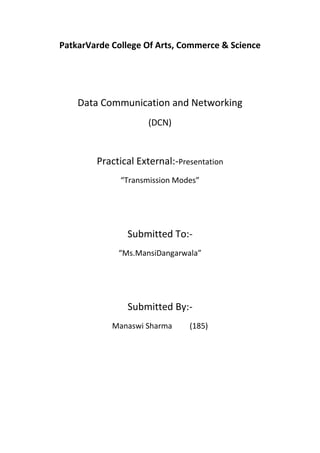
Transmission modes
- 1. PatkarVarde College Of Arts, Commerce & Science Data Communication and Networking (DCN) Practical External:-Presentation “Transmission Modes” Submitted To:- “Ms.MansiDangarwala” Submitted By:- Manaswi Sharma (185)
- 2. Data Transmission Data transmission is the physical transfer of data (a digital bit stream) over a point-to-point or point-to-multipoint communication channel. Communication channel is any physical media like cables etc. Transmission Modes Data transmission has been categorized into two type’s namely parallel and serial transmission. Serial transmission is further classified into synchronous and asynchronous transmission.
- 3. Parallel Transmission: In parallel transmission of data, all the bits of a byte are transmitted simultaneously on separate wires. This type requires multiple circuits for interconnecting the two devices. It is practically possible only if two devices are close to each other. E.g. Data transmission between computer and printer. This diagram represents parallel transmission of an 8-bit digital data. This will require 8 wires for connecting two devices.
- 4. Advantages of parallel transmission: 1. All the data bits will be transmitted simultaneously, so time required for transmission of N number of bits will be only one clock cycle. 2. Due to transmission in only one clock cycle, clock frequency can be kept low without affecting speed of operation. Disadvantages of parallel transmission: 1. Transmission of N bits will require N number of wires. 2. With increase of users these wires will be too many to handle.
- 5. Serial Transmission 1. In serial transmission of data, all the bits of a byte are transmitted serially one after the other on same wire. 2. This type doesn’t require multiple circuits for interconnecting the two devices, indeed it just requires 1 wire to connect. 3. It is practically possible in all sorts of situations close or far. 4. E.g. Data transmission between computer and computer. 5. This diagram represents serial transmission of an 8-bit digital data. 6. This will require only one wire for connecting two devices.
- 6. Advantages of serial transmission: 1. Only one wire is required. 2. Reduced cost due to less number of conductors. Disadvantages of serial transmission: 1. Speed of data transfer is low. 2. To increase speed of data transfer, clock frequency needs to be increased.
- 7. Types of Serial Transmission In data communication, Timing control of the reception of bits is important. There are two methods of timing control for reception of bits.
- 8. 1. Asynchronous data transmission: 1. In asynchronous transmission, the transmitter transmits data bytes at any instant of time. 2. Only one byte is sent at a time. There is ideal time between two data bytes. 3. Transmitter and Receiver operate at different clock frequencies. 4. To help receiver ‘start’ and ‘stop’ bits are used along with data in middle. 5. Ideal time between byte is not constant. They are also known as gaps. 6. In asynchronous transmission timing of signal is not important.
- 9. Advantages of asynchronous transmission: 1. Synch between devices is not necessary. 2. It is cheap scheme. Disadvantages of synchronous transmission: 1. Use of ‘start’ and ‘stop’ bits and gaps between data makes transmission slow. 2. Timing error can take place.
- 10. 2. Synchronous data transmission: 1. In synchronous transmission, data transmission is carried out under the control of a common master clock. 2. Bytes are transmitted as a block in a continuous stream of bits. 3. Transmitter and Receiver operate at synchronised clock frequencies. 4. No ‘start’ and ‘stop’ bits are used. 5. No need of ideal time between data bytes. 6. In synchronous transmission timing of signal is important.
- 11. Advantages of asynchronous transmission: 1. Speed of data is much higher because of no ‘start’ and ‘stop’ bits and continuity. 2. Timing errors are reduced due to synch. Disadvantages of synchronous transmission: 1. Accuracy of data is entirely dependent on timing. 2. Transmitter and Receiver needs to be properly synchronized.
